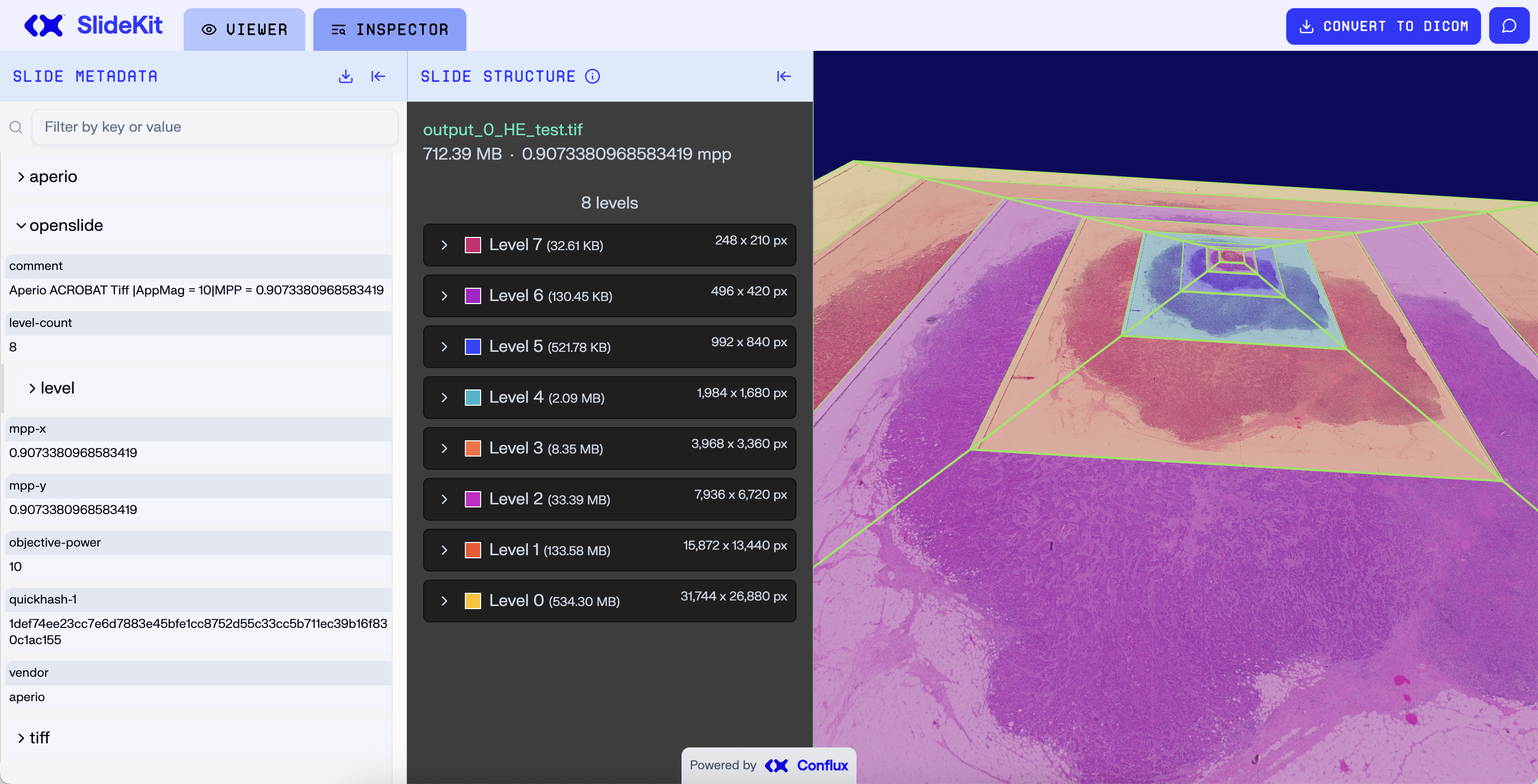

Introducing SlideKit
To help pathologists, scientists, and technologists explore Digital Pathology WSI images, we are excited to introduce SlideKit, a browser-based application that offers a swiss army knife of utilities for viewing, inspecting, and converting Digital Pathology WSIs to DICOM. As a client-side browser-native application, no installation is needed to use SlideKit: users can simply access the site, drop in their slide, and use the application immediately with all data staying local and private to their device.
Our tool is a powerful utility to interact with and manipulate WSI data. Instead of loading bulky and bespoke desktop software limited to specific devices and networks, users can now drag and drop a WSI file into their browser on any device and view the slide and detailed information on its resolution, pyramid structure, compression and more without any software installation. At the core of SlideKit’s viewer and inspector is OpenSlideWASM, an extension to OpenSlide built by Conflux that enables browser usage through WebAssembly (WASM). SlideKit uses OpenSlideWASM to efficiently fetch WSI pixel data and to extract file metadata, enabling it to support most WSI file formats. SlideCheck’s viewer is built on DeckGL, a popular WebGL-powered data visualization library that excels at rendering large datasets. To optimize performance, the viewer implements a custom tile layer that efficiently loads and caches image tiles directly from OpenSlideWASM.
Local-First Software for Healthcare
SlideKit is a local-first, browser-native application written in WebAssembly, WebGL, and React. This enables all slide processing – header extraction, layer indexing, and format conversion – to run privately on your device at near-native speeds without software installation, representing a novel computing paradigm for digital pathology.
Browsers offer powerful accelerated computing primitives (WebGL, WebAssembly, WebGPU, Origin Private File System), while also providing strong isolation between sites and other software and data on your device. Figma, a modern design tool, famously made a big bet on browsers at a time when dominant design tools were heavyweight native applications, showing that WebGL and WebAssembly can match native performance, and making it possible for many more users to access their applications.
Using these technologies, we built SlideKit to be privacy- and local- first software that doesn’t compromise on performance. Using fully memory-safe code written in Rust and compiled to WebAssembly, we’re able to process gigabyte-scale image files in various formats entirely locally in your browser: no software to install, and no slide data transmitted anywhere.
The importance of data ownership and privacy is tantamount in healthcare and SlideKit illustrates the potential of browser-native, local-first web applications in digital pathology and data-intensive diagnostic medicine broadly. We look forward to continuing to share our work to enable both broader healthcare data interoperability and the future of AI-enabled diagnostic medicine atop of the modern browser stack.
Inspecting the whole slide image pyramid

The Great Pyramid of Giza is one of the oldest and most studied structures in the world, and yet in 2023 new imaging techniques identified a previously unknown chamber hidden inside. Using non-desctructive cosmic-ray imaging, the ScanPyramids team constructed a map of the pyramid’s subterranean levels, identifying the hidden room – which they subsequently photographed with an endoscope – that had been unknown for centuries.
Like Egyptian pyramids, Digital Pathology Whole Slide Image (WSIs) are huge: often more than 10^11 pixels, or about 300GB uncompressed (assuming 3 color channels and 8 bit color depth). They are also typically stored in pyramidal formats. The full-resolution image is broken into small tiles that comprise the file’s base layer (“level 0”). Downsampled thumbnails of successively lower magnification are stored in intermediate layers (typically 3-4 smaller levels are present). This allows efficient image access at different magnification levels.
Although they lack hidden chambers, Digital Pathology WSI pyramids do have an opaque structure: it is hard to determine how many levels are present, as well as what each levels’ dimensions, tile sizes, and compression schemes are. These file structure details affect viewing performance and, in some cases, image quality – which is critical for diagnosis. They also impact interoperability – or how readily the file can be viewed in different software – which often assumes the files follow certain conventions around the presence of specific header tags, the scale of intermediate layers, or the use of certain types of compression.
SlideKit helps users to explore the internal structure of WSIs, enabling discovery of critical information necessary for downstream analysis, including insights into the metadata, levels, tile sizes, downsampling ratios, and compression schemes used within an image.
More to come
SlideKit addresses a critical need in digital pathology with a secure, efficient browser-based solution for viewing, inspecting, and converting whole slide images (WSIs). By leveraging WebAssembly, OpenSlideWASM, and Rust, we've eliminated traditional challenges of processing large files on the web—no installations, no server uploads, just powerful WSI capabilities directly in your browser. We hope our tool makes life (even slightly) simpler today for pathologists, researchers, informaticians, and anyone else working with digital pathology data by reducing the overhead needed to inspect and utilize WSI data. SlideKit provides a powerful platform for understanding and analyzing digital pathology data, but viewing and inspecting are just the beginning; we look forward to sharing how much more it can enable soon.
Want to collaborate or contribute?
We welcome feedback and are eager to hear about your experiences using SlideKit. If you are interested in our work or collaborating to enable your most pressing needs, please reach out!